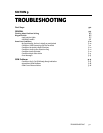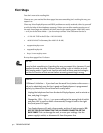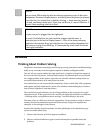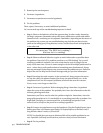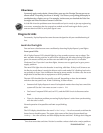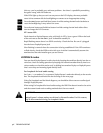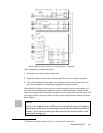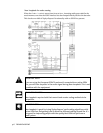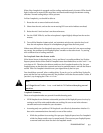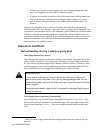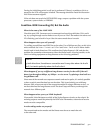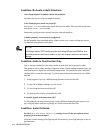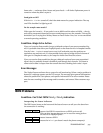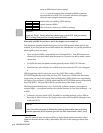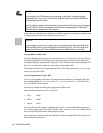
TROUBLESHOOTING 9-9
When Near Loopback is engaged and the coding methods match, the LOCK LEDs should
light. Audio can be routed to the send bus, and monitored through the RECEIVE routing
switches. Normal coding delays will be present.
In Near Loopback, you should be able to:
1. Route the mic to one or both send circuits;
2. Shout into the mic, and see the A or B routing LED turn red to indicate overload;
3. Raise the mic’s level and see it on the send meters;
4. See the LOCK LEDs lit, and the microphone’s signal slightly delayed on the receive
meters;
5. Turn off the Monitor 2 SEND switch, set its RECEIVE switch to AB, raise the level, and
hear the microphone delayed in a headphone plugged into the front panel.
If these tests fail but the Far Loopback tests pass, and you’re sure the Codec menu settings
are correct, the problem is with ZephyrExpress’ encoder or decoder circuit. Try testing
with a different set of coding methods.
Far Loopback from the distant studio
If the Status Screen is showing Ready Ready, and there’s an audio problem, but Zephyr-
Express passes the local Near and Far Loopback tests described above, set the Codec: Loop
mode
item to Off. Then have the distant studio set their Loopback mode to Far. Set your
ZephyrExpress so that both the transmit and receive methods match, and call the distant
studio. Their Far Loopback should route your signal directly back to you.
You should hear yourself, after a coding delay. If you do, you’ve verified that ZephyrEx-
press and the line are working correctly: the problem is with the distant studio’s codec. If
you don’t, try changing the Codec: bitrate.
w
NOTE!
Don’t forget to set Codec: Loop mode back to Off before attempting normal
operation.
Loopback Summary
These two loopbackmodes are powerful troubleshooting tools:
• NEAR loopback can eliminate substantial portions of the ZephyrExpress circuitry by
testing to see if the coder and decoder are working. Be sure to test in the relevant
transmit and receive modes for your situation.
• Assuming only one problem, FAR loopback can effectively determine whether it’s
due to the communications channel(s) or one of the codecs.
• While the problem is occurring, first put your ZephyrExpress into Far Loopback
while the distant studio stays in normal mode. Then restore your ZephyrExpress
to normal and have them use their far loopback mode.



